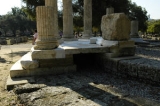
Crepidoma
Encyclopedia

Ancient Greek
Ancient Greek is the stage of the Greek language in the periods spanning the times c. 9th–6th centuries BC, , c. 5th–4th centuries BC , and the c. 3rd century BC – 6th century AD of ancient Greece and the ancient world; being predated in the 2nd millennium BC by Mycenaean Greek...
buildings. The crepidoma is the platform of, usually, three levels upon which the superstructure of the building is erected. The levels typically decrease in size incrementally, forming a series of steps along all or some sides of the building. The crepidoma rests on the euthynteria
Euthynteria
Euthynteria is the ancient Greek term for the uppermost course of a building's foundations, partly emerging from groundline. The superstructure of the building were set on the euthynteria. Archaeologists and architects use the term in discussion of Classical architecture.-References:Robertson, D....
(foundation), which is normally constructed of locally available stone for the sake of economy.
The topmost level of the crepidoma is termed the stylobate
Stylobate
In classical Greek architecture, a stylobate is the top step of the crepidoma, the stepped platform on which colonnades of temple columns are placed...
, because it is the platform for the columns . The lower levels of the crepidoma are termed the “stereobate”. The step-like arrangement of the crepidoma may extend around all four sides of a structure like a temple: e.g. the Parthenon
Parthenon
The Parthenon is a temple on the Athenian Acropolis, Greece, dedicated to the Greek goddess Athena, whom the people of Athens considered their virgin patron. Its construction began in 447 BC when the Athenian Empire was at the height of its power. It was completed in 438 BC, although...
. On some temples, the steps extend only across the front façade, or they may wrap around the sides for a short distance, a detail that is termed a “return”: e.g. the temple of Despoina at Lycosoura
Lycosura
Lycosura was a city of Arcadia said by Pausanias to be the oldest city in the world, though there is no evidence for its existence before the fourth century BCE...
.
It is common for the hidden portions of each level of the stereobate to be of a lower grade of material than the exposed elements of the steps and the stylobate; each higher level of the crepidoma typically covers the clamps used to hold the stones of the lower level together. The lower margins of each level of the crepidoma blocks are often cut back in a series of two or three steps to create shadow lines; this decorative technique is termed a “reveal.”

